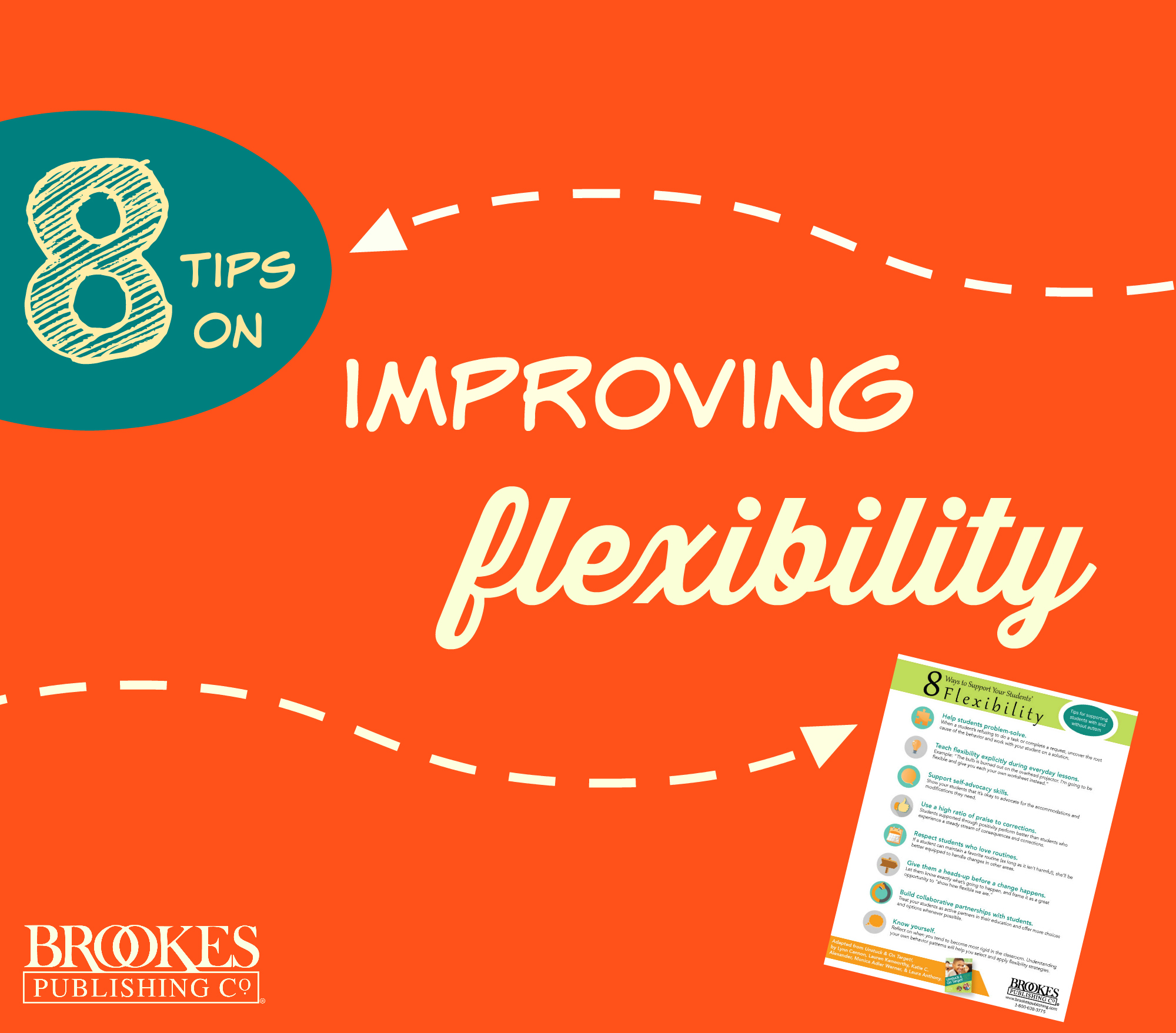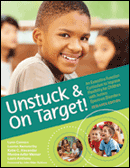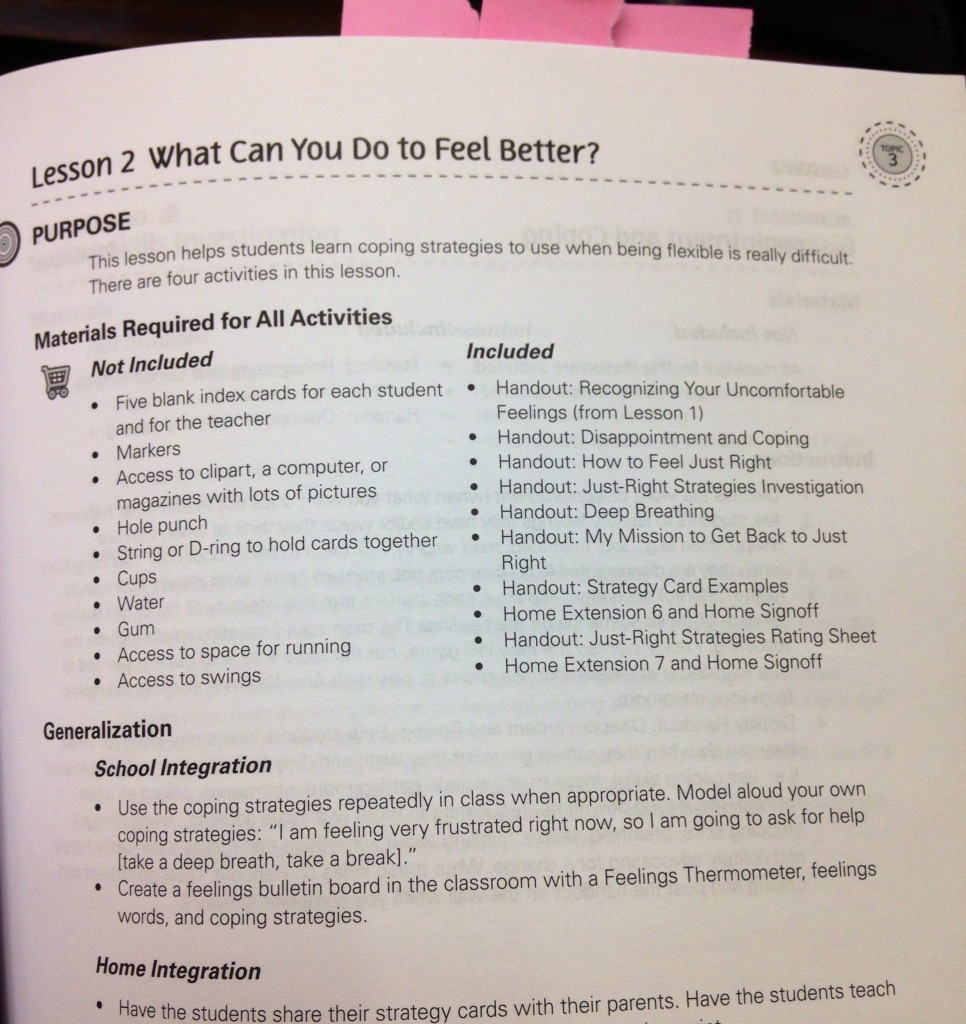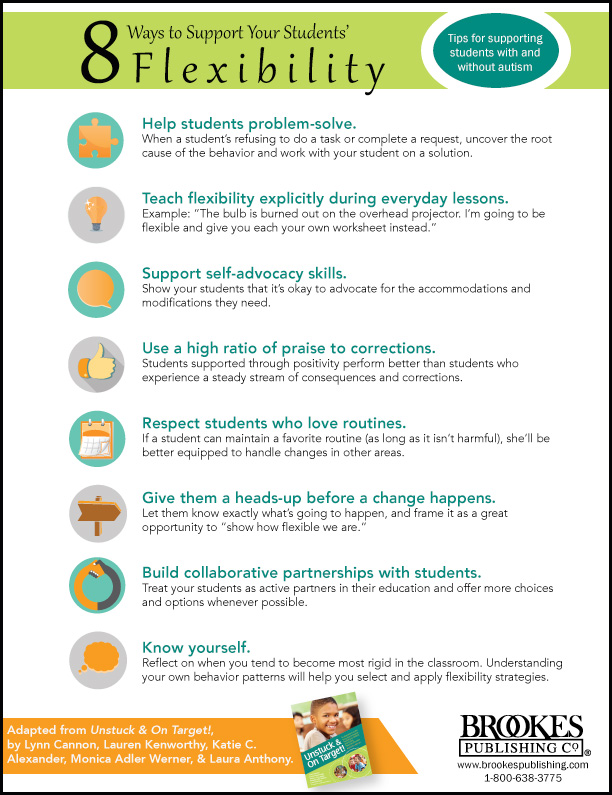8 Ways to Support Your Students’ Flexibility
July 2, 2015
 Cognitive flexibility is one of the most important qualities that students AND teachers can cultivate. Learning is easier when kids and their teachers can tolerate change, open themselves to new experiences, solve problems creatively, and take the unexpected in stride. Flexibility isn’t always an easy thing to develop–but as Lynn Cannon and her colleagues stress in their book Unstuck & On Target!, it’s also a skill that can be explicitly taught.
Cognitive flexibility is one of the most important qualities that students AND teachers can cultivate. Learning is easier when kids and their teachers can tolerate change, open themselves to new experiences, solve problems creatively, and take the unexpected in stride. Flexibility isn’t always an easy thing to develop–but as Lynn Cannon and her colleagues stress in their book Unstuck & On Target!, it’s also a skill that can be explicitly taught.
So what are the first steps toward supporting flexibility in your classroom? Here are 8 guidelines to get you started, adapted from Unstuck & On Target! This executive function curriculum was developed to help kids with autism improve flexibility, but the suggestions below work for any student struggling with this skill. (Like this topic? Let us know in the comments section below, and we’ll offer some specific activities in a future post!)
 Help students problem-solve. When a student’s refusing to do a task or complete a request, steer clear of assumptions like “he’s just being difficult.” Dig deeper with your student to uncover the root cause of the behavior. If he’s refusing to do a writing task, for example, it could be that he doesn’t know how to start or has trouble with fine motor skills. Demonstrate your flexibility by working with your student to find a solution–could he get unstuck by using a computer to complete the task instead of a pencil and paper?
Help students problem-solve. When a student’s refusing to do a task or complete a request, steer clear of assumptions like “he’s just being difficult.” Dig deeper with your student to uncover the root cause of the behavior. If he’s refusing to do a writing task, for example, it could be that he doesn’t know how to start or has trouble with fine motor skills. Demonstrate your flexibility by working with your student to find a solution–could he get unstuck by using a computer to complete the task instead of a pencil and paper?- Teach flexibility explicitly. For many students, including students on the autism spectrum, the benefits of flexibility aren’t immediately clear. Shine a bright light on the how and why of flexibility by teaching it out loud during your everyday lessons. Is the bulb on your overhead projector burned out? Tell your students “I wanted to use the overhead projector to show you this worksheet, but the bulb is burned out. I’m going to be flexible and give you each your own worksheet instead.” When you model flexibility explicitly during daily classroom routines, your students will see how it applies to their real lives–and how it helps keep problems from becoming insurmountable.
- Teach self-advocacy skills. Show your students that it’s okay to advocate for what they need. Try some gentle prompting to help a student uncover and vocalize her needs: I’ve noticed you cover your ears in the cafeteria, and that makes it hard for you to eat lunch. Can you help think of a less noisy place that would make you more comfortable at lunchtime?
 Use a high ratio of praise to corrections. Aim for 4 praises for every 1 correction. This is a key component of a flexible, supportive classroom culture: students supported through positive words and actions perform better than students who experience a steady stream of consequences and corrections.
Use a high ratio of praise to corrections. Aim for 4 praises for every 1 correction. This is a key component of a flexible, supportive classroom culture: students supported through positive words and actions perform better than students who experience a steady stream of consequences and corrections.- Reassure students who love routines. Do you teach a student who has a specific self-soothing routine? It’s a good idea to respect her routine instead of asking her to change it (unless it’s harmful or prevents her from completing her work). If a student can maintain a routine she finds helpful, she’ll be better equipped to handle changes in other areas.
- Give them a heads-up before a change happens. Many students (both with and without autism) experience high levels of stress during a change in their routine or classroom environment–and a stressed student will find it really tough to be flexible. You can help by priming students ahead of time for the change. Let them know exactly what’s going to happen, and frame it as a great opportunity to “show how flexible we are.”
 Build collaborative partnerships with students. Treat your students as active partners in their education and listen to what they have to say. That doesn’t mean you have to “give in” to students or lower your expectations–but it does mean demonstrating flexibility and offering more choices. Brainstorm options for students stuck on a task: could they choose their own essay topic? Compose on a computer in a quiet area instead of at a desk? Take a five-minute break when they feel overwhelmed? Giving students a bigger voice in their education helps all kids (and may be especially beneficial for kids on the autism spectrum, many of whom appreciate a strong sense of control).
Build collaborative partnerships with students. Treat your students as active partners in their education and listen to what they have to say. That doesn’t mean you have to “give in” to students or lower your expectations–but it does mean demonstrating flexibility and offering more choices. Brainstorm options for students stuck on a task: could they choose their own essay topic? Compose on a computer in a quiet area instead of at a desk? Take a five-minute break when they feel overwhelmed? Giving students a bigger voice in their education helps all kids (and may be especially beneficial for kids on the autism spectrum, many of whom appreciate a strong sense of control).- Know yourself. Reflect on when you tend to become most rigid in the classroom. Do certain behaviors act as triggers for you? Are you less flexible when interacting with certain students? Understanding your own behavior patterns in the classroom will help you select and apply flexibility strategies.
SHARE THE INFOGRAPHIC
Like the tips in today’s post? Here they are in an infographic. Please pin and share the love!
 If you want specific activities, scripts, and coping strategies that help improve your students’ flexibility, Unstuck & On Target! has pretty much everything you need (plus a great foreword by John Elder Robison). Do you use this book already? Tell us what you think in the comments–we’d love to hear about your experience!
If you want specific activities, scripts, and coping strategies that help improve your students’ flexibility, Unstuck & On Target! has pretty much everything you need (plus a great foreword by John Elder Robison). Do you use this book already? Tell us what you think in the comments–we’d love to hear about your experience!






Write a Comment
Your email address will not be published. Required fields are marked *
Post a Comment